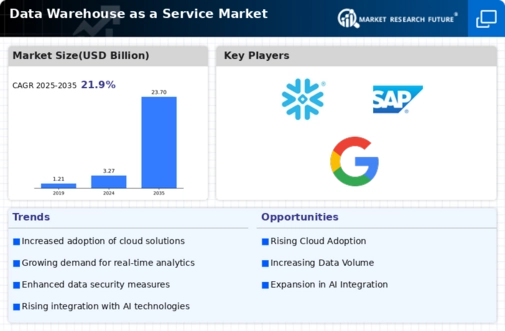-
Executive Summary
-
1.1
-
Market Attractiveness Analysis
-
Global Data Warehouse
-
as a Service Market, by Usage
-
Global Data Warehouse
-
as a Service Market, by Deployment
-
Global Data Warehouse
-
as a Service Market, by Organization Size
-
Global Data
-
Warehouse as a Service Market, by Application
-
Global
-
Data Warehouse as a Service Market, by Vertical
-
Data
-
Warehouse as a Service Market, by Region
-
Scope of the Report
-
Market Definition
-
Scope of the
-
Study
-
Market Structure
-
Key
-
Buying Criteria
-
Macro Factor Indicator Analysis
-
3
-
Market Research Methodology
-
Research Process
-
Primary Research
-
Secondary Research
-
Market Size Estimation
-
Forecast
-
Model
-
List of Assumptions
-
Market
-
Insights
-
Industry Overview of the Global Data Warehouse
-
as a Service Market
-
Introduction
- Regulations and Standards
- Significant
- Growing Adoption of Private Cloud
-
5.2
-
Drivers
-
Increase in Data Volume
-
5.2.4
-
Drivers Impact Analysis
-
Restraints
- Security
- Restraints Impact Analysis
- Increasing Demand from SME’s
- Growing
-
and Privacy Concerns
-
5.4
-
Opportunities
-
Applications across Verticals
-
Market Factor Analysis
-
Porter’s Five Forces Analysis
- Bargaining Power of Suppliers
- Bargaining Power of Buyers
- Threat
- Intensity of Rivalry
-
6.1.1
-
Threat of New Entrants
-
of Substitutes
-
6.2
-
Value Chain/Supply Chain of the Global Data Warehouse as a Service Market
-
Global Data Warehouse as a Service Market, by Usage
-
7.1
-
Introduction
-
Data Mining
- Market Estimates
- Market Estimates & Forecast, by Region,
-
& Forecast, 2023–2030
-
Reporting
- Market Estimates
- Market Estimates & Forecast, by Region,
-
& Forecast, 2023–2030
-
Analytics
- Market Estimates
- Market Estimates & Forecast, by Region,
-
& Forecast, 2023–2030
-
Global Data Warehouse as a Service Market,
-
by Deployment Type
-
Introduction
- Market Estimates & Forecast, 2023–2030
- Market Estimates & Forecast, by Region, 2023–2030
- Market Estimates & Forecast, 2023–2030
- Market Estimates & Forecast, by Region, 2023–2030
- Market Estimates & Forecast, 2023–2030
- Market Estimates & Forecast, by Region, 2023–2030
-
8.2
-
Private Cloud
-
8.3
-
Public Cloud
-
8.4
-
Hybrid Cloud
-
9.
-
Global Data Warehouse as a Service Market, by Organization Size
-
9.1
-
Introduction
-
Large Enterprises
- Market
- Market Estimates & Forecast,
-
Estimates & Forecast, 2023–2030
-
by Region, 2023–2030
-
Small and Medium-Sized Enterprises
- Market Estimates & Forecast, 2023–2030
- Market Estimates
-
& Forecast, by Region, 2023–2030
-
Global Data Warehouse
-
as a Service Market, by Application
-
Introduction
-
Fraud Detection and Threat Management
- Market
- Market Estimates & Forecast,
-
Estimates & Forecast, 2023–2030
-
by Region, 2023–2030
-
Supply Chain Management
- Market Estimates & Forecast, 2023–2030
- Market Estimates
-
& Forecast, by Region, 2023–2030
-
Asset Management
- Market Estimates & Forecast, 2023–2030
- Market Estimates
-
& Forecast, by Region, 2023–2030
-
Risk and
- Market Estimates & Forecast, 2023–2030
- Market Estimates & Forecast, by Region, 2023–2030
- Market Estimates & Forecast, 2023–2030
- Market Estimates & Forecast, by Region, 2023–2030
- Market Estimates & Forecast, 2023–2030
-
Compliance Management
-
10.6
-
Customer Analytics
-
10.7
-
Others
-
10.7.2
-
Market Estimates & Forecast, by Region, 2023–2030
-
11.
-
Global Data Warehouse as a Service Market, by Vertical
-
Introduction
-
BFSI
- Market Estimates & Forecast, 2023–2030
- Market Estimates & Forecast, by Region, 2023–2030
- Market Estimates & Forecast, 2023–2030
- Market Estimates & Forecast, by Region, 2023–2030
- Market Estimates & Forecast, 2023–2030
- Market Estimates & Forecast, by Region, 2023–2030
- Market Estimates & Forecast,
- Market Estimates & Forecast, by Region, 2023–2030
-
11.3
-
Retail & Ecommerce
-
11.4
-
Telecommunication and IT
-
11.5
-
Healthcare and Life Sciences
-
Manufacturing and Automotive
- Market Estimates
- Market Estimates & Forecast, by
-
& Forecast, 2023–2030
-
Region, 2023–2030
-
Government and Public Sector
- Market Estimates & Forecast, 2023–2030
- Market Estimates
-
& Forecast, by Region, 2023–2030
-
Travel and
- Market Estimates & Forecast, 2023–2030
-
Hospitality
-
11.8.2
-
Market Estimates & Forecast, by Region, 2023–2030
-
11.9
-
Media and Entertainment
-
11.10
-
Others
-
11.10.2
-
Market Estimates & Forecast, 2023–2030
-
Market Estimates & Forecast, by Region, 2023–2030
-
Market Estimates & Forecast, 2023–2030
-
Market Estimates & Forecast, by Region, 2023–2030
-
12.
-
Global Data Warehouse as a Service Market, by Region
-
12.1
-
Introduction
-
North America
- Market
- Market Estimates & Forecast,
- Market Estimates & Forecast, by Deployment
- Market Estimates & Forecast, by Organization
- Market Estimates & Forecast, by Application,
- Market Estimates & Forecast, by Vertical, 2023–2030
- US
-
Estimates & Forecast, 2023–2030
-
by Usage, 2023–2030
-
Mode, 2023–2030
-
Size, 2023–2030
-
12.2.7.6
-
Market Estimates & Forecast, by Vertical, 2023–2030
-
12.2.8
-
Canada
-
12.2.8.2
-
Market Estimates & Forecast, 2023–2030
-
Market Estimates & Forecast, by Usage, 2023–2030
-
Estimates & Forecast, by Deployment Mode, 2023–2030
-
Estimates & Forecast, by Organization Size, 2023–2030
-
Estimates & Forecast, by Application, 2023–2030
-
& Forecast, by Vertical, 2023–2030
-
Estimates & Forecast, by Usage, 2023–2030
-
& Forecast, by Deployment Mode, 2023–2030
-
& Forecast, by Organization Size, 2023–2030
-
& Forecast, by Application, 2023–2030
-
Forecast, by Vertical, 2023–2030
-
& Forecast, by Usage, 2023–2030
-
by Deployment Mode, 2023–2030
-
by Organization Size, 2023–2030
-
by Application, 2023–2030
-
Vertical, 2023–2030
-
12.3.7.1
-
Market Estimates & Forecast, 2023–2030
-
& Forecast, by Usage, 2023–2030
-
by Deployment Mode, 2023–2030
-
by Organization Size, 2023–2030
-
by Application, 2023–2030
-
Vertical, 2023–2030
-
12.3.8.1
-
Market Estimates & Forecast, 2023–2030
-
& Forecast, by Usage, 2023–2030
-
by Deployment Mode, 2023–2030
-
by Organization Size, 2023–2030
-
by Application, 2023–2030
-
Vertical, 2023–2030
-
Estimates & Forecast, 2023–2030
-
by Usage, 2023–2030
-
Mode, 2023–2030
-
Size, 2023–2030
-
& Forecast, 2023–2030
-
by Usage, 2023–2030
-
Mode, 2023–2030
-
Size, 2023–2030
-
12.4.6
-
Market
-
Market
-
Market
-
Market Estimates
-
Mexico
-
Market Estimates & Forecast, 2023–2030
-
Market
-
Market Estimates
-
Market Estimates
-
Market Estimates
-
Market Estimates &
-
Europe
- Market Estimates & Forecast, 2023–2030
- Market Estimates
- Market Estimates & Forecast,
- Market Estimates & Forecast,
- Market Estimates & Forecast,
- Market Estimates & Forecast, by
- Germany
- France
- UK
- Rest of Europe
-
Asia-Pacific
- Market Estimates & Forecast,
- Market Estimates & Forecast, by Usage, 2023–2030
- Market Estimates & Forecast, by Deployment Mode, 2023–2030
- Market Estimates & Forecast, by Organization Size, 2023–2030
- Market Estimates & Forecast, by Application, 2023–2030
-
Market Estimates & Forecast, by Vertical, 2023–2030
-
12.4.7
-
China
-
12.4.7.2
-
Market Estimates & Forecast, 2023–2030
-
Market Estimates & Forecast, by Usage, 2023–2030
-
Estimates & Forecast, by Deployment Mode, 2023–2030
-
Estimates & Forecast, by Organization Size, 2023–2030
-
Estimates & Forecast, by Application, 2023–2030
-
& Forecast, by Vertical, 2023–2030
-
Estimates & Forecast, by Usage, 2023–2030
-
& Forecast, by Deployment Mode, 2023–2030
-
& Forecast, by Organization Size, 2023–2030
-
& Forecast, by Application, 2023–2030
-
Forecast, by Vertical, 2023–2030
-
Estimates & Forecast, by Usage, 2023–2030
-
& Forecast, by Deployment Mode, 2023–2030
-
& Forecast, by Organization Size, 2023–2030
-
& Forecast, by Application, 2023–2030
-
Forecast, by Vertical, 2023–2030
-
Estimates & Forecast, by Usage, 2023–2030
-
& Forecast, by Deployment Mode, 2023–2030
-
& Forecast, by Organization Size, 2023–2030
-
& Forecast, by Application, 2023–2030
-
& Forecast, by Vertical, 2023–2030
-
of the World
-
12.5.3
-
Market
-
Market
-
Market
-
Market Estimates
-
India
-
Market Estimates & Forecast, 2023–2030
-
Market
-
Market Estimates
-
Market Estimates
-
Market Estimates
-
Market Estimates &
-
Japan
-
Market Estimates & Forecast, 2023–2030
-
Market
-
Market Estimates
-
Market Estimates
-
Market Estimates
-
Market Estimates &
-
Rest of Asia-Pacific
-
Market Estimates & Forecast, 2023–2030
-
Market
-
Market Estimates
-
Market Estimates
-
Market Estimates
-
Market Estimates
-
Rest
- Market Estimates & Forecast, 2023–2030
- Market Estimates & Forecast, by Usage, 2023–2030
-
Market Estimates & Forecast, by Deployment Mode, 2023–2030
-
12.5.4
-
Market Estimates & Forecast, by Organization Size, 2023–2030
-
12.5.5
-
Market Estimates & Forecast, by Application, 2023–2030
-
Estimates & Forecast, by Vertical, 2023–2030
-
12.5.7
-
Middle East & Africa
-
12.5.7.3
-
Market
-
Market Estimates & Forecast, 2023–2030
-
Market Estimates & Forecast, by Usage, 2023–2030
-
Market Estimates & Forecast, by Deployment Mode, 2023–2030
-
12.5.7.4
-
Market Estimates & Forecast, by Organization Size, 2023–2030
-
12.5.7.5
-
Market Estimates & Forecast, by Application, 2023–2030
-
Estimates & Forecast, by Vertical, 2023–2030
-
12.5.8
-
South America
-
12.5.8.3
-
Market
-
Market Estimates & Forecast, 2023–2030
-
Market Estimates & Forecast, by Usage, 2023–2030
-
Market Estimates & Forecast, by Deployment Mode, 2023–2030
-
12.5.8.4
-
Market Estimates & Forecast, by Organization Size, 2023–2030
-
12.5.8.5
-
Market Estimates & Forecast, by Application, 2023–2030
-
Estimates & Forecast, by Vertical, 2023–2030
-
Market
-
Company Landscape
-
Competitive Overview
-
Competitor
-
Dashboard
-
Major Growth Strategies in the Global Data
-
Warehouse as a Service Market
-
Competitive Benchmarking
-
Market Share Analysis
-
XXXX:
-
The leading player in terms of number of developments in the Global Data Warehouse
-
as a Service Market
-
Key Developments & Growth Strategies
- Product Launches/Service Deployment
- Joint Ventures
- Business Expansion
-
13.7.2
-
Mergers & Acquisitions
-
Company Profiles
-
Microsoft Corporation
- Company
- Product/Business Segment Overview
- Key Developments
- Company Overview
- Product/Business Segment Overview
- Key Developments
- Company Overview
- Financial
- Key Developments
-
Overview
-
14.1.3
-
Financial Updates
-
14.2
-
Amazon Web Services
-
14.2.3
-
Financial Updates
-
14.3
-
Oracle Corporation
-
14.3.2
-
Product/Business Segment Overview
-
Updates
-
SAP
- Company Overview
- Product/Business
- Financial Updates
-
SE
-
Segment Overview
-
14.4.4
-
Key Developments
-
Google
- Product/Business Segment Overview
- Financial Updates
- Key Developments
-
14.5.1
-
Company Overview
-
IBM Corporation
- Company Overview
- Product/Business Segment Overview
- Key Developments
- Company Overview
- Financial
- Key Developments
-
14.6.3
-
Financial Updates
-
14.7
-
AtScale, Inc.
-
14.7.2
-
Product/Business Segment Overview
-
Updates
-
Teradata
- Company Overview
- Financial
- Key Developments
-
Corporation
-
14.8.2
-
Product/Business Segment Overview
-
Updates
-
Actian
- Company Overview
- Financial
- Key Developments
-
Corporation
-
14.9.2
-
Product/Business Segment Overview
-
Updates
-
Hortonworks
- Company Overview
- Product/Business
- Financial Updates
-
Segment Overview
-
14.10.4
-
Key Developments
-
Veeva Systems Inc.
- Product/Business Segment Overview
- Financial Updates
- Key
-
14.11.1
-
Company Overview
-
Developments
-
Micro Focus
- Company
- Product/Business Segment Overview
- Key Developments
- Company Overview
- Financial
- Key Developments
-
Overview
-
14.12.3
-
Financial Updates
-
14.13
-
MarkLogic Corporation
-
14.13.2
-
Product/Business Segment Overview
-
Updates
-
Netavis
- Company Overview
- Financial
- Key Developments
-
Software GmbH
-
14.14.2
-
Product/Business Segment Overview
-
Updates
-
Snowflake
- Company Overview
- Product/Business
- Financial Updates
-
Inc.
-
Segment Overview
-
14.15.4
-
Key Developments
-
Conclusion
-
LIST OF TABLES
-
Global Data Warehouse
-
as a Service Market, by Region, 2023–2030
-
Table 2
-
North America: Data Warehouse as a Service Market, by Country, 2023–2030
-
Europe: Data Warehouse as a Service Market,
-
by Country, 2023–2030
-
Asia-Pacific:
-
Data Warehouse as a Service Market, by Country, 2023–2030
-
Table
-
Middle East & Africa: Data Warehouse as a Service Market,
-
by Country, 2023–2030
-
South America:
-
Data Warehouse as a Service Market, by Country, 2023–2030
-
Table
-
Global Data Warehouse as a Service Usage Market, by Region,
-
North America: Data Warehouse
-
as a Service Usage Market, by Country, 2023–2030
-
Table 9
-
Europe: Data Warehouse as a Service Usage Market, by Country, 2023–2030
-
Table10 Asia-Pacific: Data Warehouse as a Service
-
Usage Market, by Country, 2023–2030
-
Table11 Middle
-
East & Africa: Data Warehouse as a Service Usage Market, by Country, 2023–2030
-
Table12 South America: Data Warehouse as a Service
-
Usage Market, by Country, 2023–2030
-
Table13 Global
-
Data Warehouse as a Service Deployment Mode Market, by Region, 2023–2030
-
Table14 North America: Data Warehouse as a Service Deployment
-
Mode Market, by Country, 2023–2030
-
Table15 Europe:
-
Data Warehouse as a Service Deployment Mode Market, by Country, 2023–2030
-
Table16 Asia-Pacific: Data Warehouse as a Service
-
Deployment Mode Market, by Country, 2023–2030
-
Table17
-
Middle East & Africa: Data Warehouse as a Service Deployment Mode Market,
-
by Country, 2023–2030
-
Table18 South America:
-
Data Warehouse as a Service Deployment Mode Market, by Country, 2023–2030
-
Table19 Global Data Warehouse as a Service Vertical
-
Market, by Region, 2023–2030
-
Table20 North America:
-
Data Warehouse as a Service Vertical Market, by Country, 2023–2030
-
Table21 Europe: Data Warehouse as a Service Vertical Market,
-
by Country, 2023–2030
-
Table22 Asia-Pacific:
-
Data Warehouse as a Service Vertical Market, by Country, 2023–2030
-
Table23 Middle East & Africa: Data Warehouse as a Service
-
Vertical Market, by Country, 2023–2030
-
Table24 South
-
America: Data Warehouse as a Service Vertical Market, by Country, 2023–2030
-
Table25 Global Data Warehouse as a Service Usage Market,
-
by Region, 2023–2030
-
Table26 Global Data Warehouse
-
as a Service Deployment Type Market, by Region, 2023–2030
-
Table27
-
Global Data Warehouse as a Service Vertical Market, by Region, 2023–2030
-
Table28 North America: Data Warehouse as a Service
-
Market, by Country
-
Table29 North America: Data Warehouse
-
as a Service Market, by Usage
-
Table30 North America: Data
-
Warehouse as a Service Market, by Deployment Type
-
Table31 North
-
America: Data Warehouse as a Service Market, by Vertical
-
Table32
-
Europe: Data Warehouse as a Service Market, by Country
-
Table33
-
Europe: Data Warehouse as a Service Market, by Usage
-
Table34
-
Europe: Data Warehouse as a Service Market, by Deployment Type
-
Table
-
Europe: Data Warehouse as a Service Market, by Vertical
-
Table36 Asia-Pacific: Data Warehouse as a Service Market, by
-
Country
-
Table37 Asia-Pacific: Data Warehouse as a
-
Service Market, by Usage
-
Table38 Asia-Pacific: Data Warehouse
-
as a Service Market, by Deployment Type
-
Asia-Pacific:
-
Data Warehouse as a Service Market, by Vertical
-
Table40 Middle
-
East & Africa: Data Warehouse as a Service Market, by Country
-
Table41
-
Middle East & Africa: Data Warehouse as a Service Market, by Usage
-
Table42 Middle East & Africa: Data Warehouse as a Service
-
Market, by Deployment Type
-
Table43 Middle East & Africa:
-
Data Warehouse as a Service Market, by Vertical
-
Table44 South
-
America: Data Warehouse as a Service Market, by Country
-
Table45
-
South America: Data Warehouse as a Service Market, by Usage
-
Table46
-
South America: Data Warehouse as a Service Market, by Deployment Type
-
Table47 South America: Data Warehouse as a Service Market, by
-
Vertical
-
LIST OF FIGURES
-
Global Data Warehouse as a Service
-
Market Segmentation
-
Forecast Methodology
-
Porter’s
-
Five Forces Analysis of the Global Data Warehouse as a Service Market
-
FIGURE
-
Value Chain of the Global Data Warehouse as a Service Market
-
FIGURE
-
Share of the Global Data Warehouse as a Service Market, by Country, 2023 (in %)
-
Global Data Warehouse as a Service Market, 2023–2030
-
FIGURE
-
Sub-Segments of Usage
-
Global Data Warehouse as a Service Market
-
Size, by Usage, 2023
-
Share of the Global Data Warehouse as a Service
-
Market, by Usage, 2023–2030
-
Global Data Warehouse as a Service
-
Market Size, by Deployment Type, 2023
-
Share of the Global Data Warehouse
-
as a Service Market, by Deployment Type, 2023–2030
-
Global Data Warehouse as a Service Market Size, by Vertical, 2023–2030
-
Share of Global Data Warehouse as a Service Market, by
-
Vertical, 2023–2030










Leave a Comment